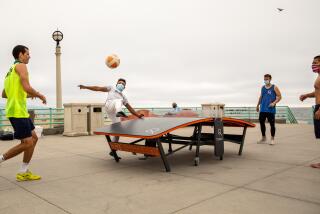Adding Clout to the Lineup
- Share via
Shopping at Kramer Sporting Goods in Santa Monica last week, Aaron Turner ran his hands across a rack of aluminum Easton bats and fondly recalled his days as a high school center fielder.
With a swing of his arms, the 21-year-old college sophomore talked about his own Easton bat.
“I still have it.... I would recommend it to kids looking for something that has the most pop,” Turner said, referring to how well a ball travels when it comes off a bat.
At bat maker and sport equipment manufacturer Easton-Bell Sports Inc. in Van Nuys, company executives are looking for a pop of their own -- in sales.
Easton-Bell is the product of a $400-million sporting-goods deal that took place in March when Riddell Bell Holdings acquired Easton Sports Inc. and brought together several well-known equipment product lines for team sports: bats and hockey sticks from Easton and football helmets from Riddell.
“Each one was a best-in-class,” Easton-Bell Chief Executive Tony Palma said of the pre-merger companies. “Overall, the combined company will be better than the individual companies.”
The key to the acquisition, he said, was that it would allow for crossovers in product development, ultimately leading to increased sales.
Palma explained, for example, that Easton-Bell would be able to combine Easton’s expertise in hockey equipment with Riddell’s know-how in football helmets to venture into making headgear for hockey players.
The new company’s revenue could nearly double to $1 billion within five years, said Palma, who served as president and chief executive of Easton Sports for 11 years. In 2005, the two companies together racked up $600 million in sales.
The merger came as little surprise to Mike May, spokesman for the Sporting Goods Manufacturers Assn., a Washington-based trade and lobbying group.
Takeovers are a “meeting of the minds, meeting of the inventories,” he said. “Adidas-Reebok is a good example. One of the things Adidas saw in Reebok was licensing deals with the pro leagues.”
May said there had been a lot of consolidation in the industry in recent years: Adidas-Salomon bought Reebok in 2005, Russell Corp. acquired Brooks Sports Inc. in 2004 and the Sports Authority Inc. and Gart Sports Co. combined in 2003.
He added that one of the main draws of mergers like these is that bigger companies have more leverage when dealing with retailers.
“If you have more brands, you’re able to command more and better shelf space, which might elbow out the competition ... but won’t completely eliminate them,” May said. “You’re in a better position at the bargaining table with the retailer.”
U.S. wholesale revenue for sports equipment, footwear and apparel totaled about $54 billion last year and retail revenue hit about $85 billion, according to the Sporting Good Manufacturers Assn.
Palma’s goal is not to tell retailers that they need his products but to make retailers want his products, he said.
Palma gave Apple Computer Inc.’s iPod as an example, saying, “Stores are begging for iPods” because shoppers want the gadgets.
Creating demand for a product is a constant challenge for the industry.
“In the sporting goods market, you don’t have a lot of growth,” said Richard Heckman, chairman and chief executive of K2 Inc., one of Easton-Bell’s main competitors, whose baseball brands include Rawlings and Worth. “There aren’t going to be 10 million new kids in baseball next year.”
“It’s not like the guy who invented the BlackBerry and now everybody wants a BlackBerry. Or a better example would be an iPod,” Heckman said.
At Easton-Bell, the research and development teams consistently work on what Palma calls “practical R&D;” -- refining and improving existing products, most of which become available to consumers.
In addition, they work on edgy new ideas even though only about one in 10 of the products ends up on store shelves.
“R&D; is the heartbeat of the overall company,” Palma said of his research and development groups. “You have to kiss a lot of frogs to find a prince. Some chances and risks can yield great returns.”
Consider the company’s line of bats called Stealth Comp CNT, short for carbon nanotube technology.
They are marketed as having bigger sweet spots and allowing for more flexibility. It took several years for the product line to launch. At the same time, the R&D; team developed other items that never entered the marketplace.
Six different research and development teams within Easton-Bell Sports are instructed to work under a five-year time frame so that they can “develop their wildest ideas,” Palma said.
The bat factory at the company’s headquarters in Van Nuys is evidence of this commitment to innovation.
At the 130,000-square-foot plant, which produces about 2 million bats a year, a “cannon” measures a bat’s durability by shooting baseballs at 700 mph at the same spot on the bat.
Meanwhile, at another testing station, a “bat robot” swats at balls to measure the bat’s performance.
But one crucial testing area is very low-tech: Easton-Bell’s batting cage, where high school, college and, occasionally, professional athletes are invited to swing the company’s wares.
Palma said he doesn’t want to offer the cheapest items on the market. And he doesn’t want to have the most goods on the market. He just wants to create the best products.
And that’s part of the reason Palma invites players to test the goods inside the Easton-Bell Sports batting cage -- because machines can’t, after all, tell him whether or not they like the way a bat feels.
“If they love it here,” Palma said of the players, “they’ll love it out there.”
*
Times staff writer Tanya Caldwell contributed to this report.
More to Read
Inside the business of entertainment
The Wide Shot brings you news, analysis and insights on everything from streaming wars to production — and what it all means for the future.
You may occasionally receive promotional content from the Los Angeles Times.










